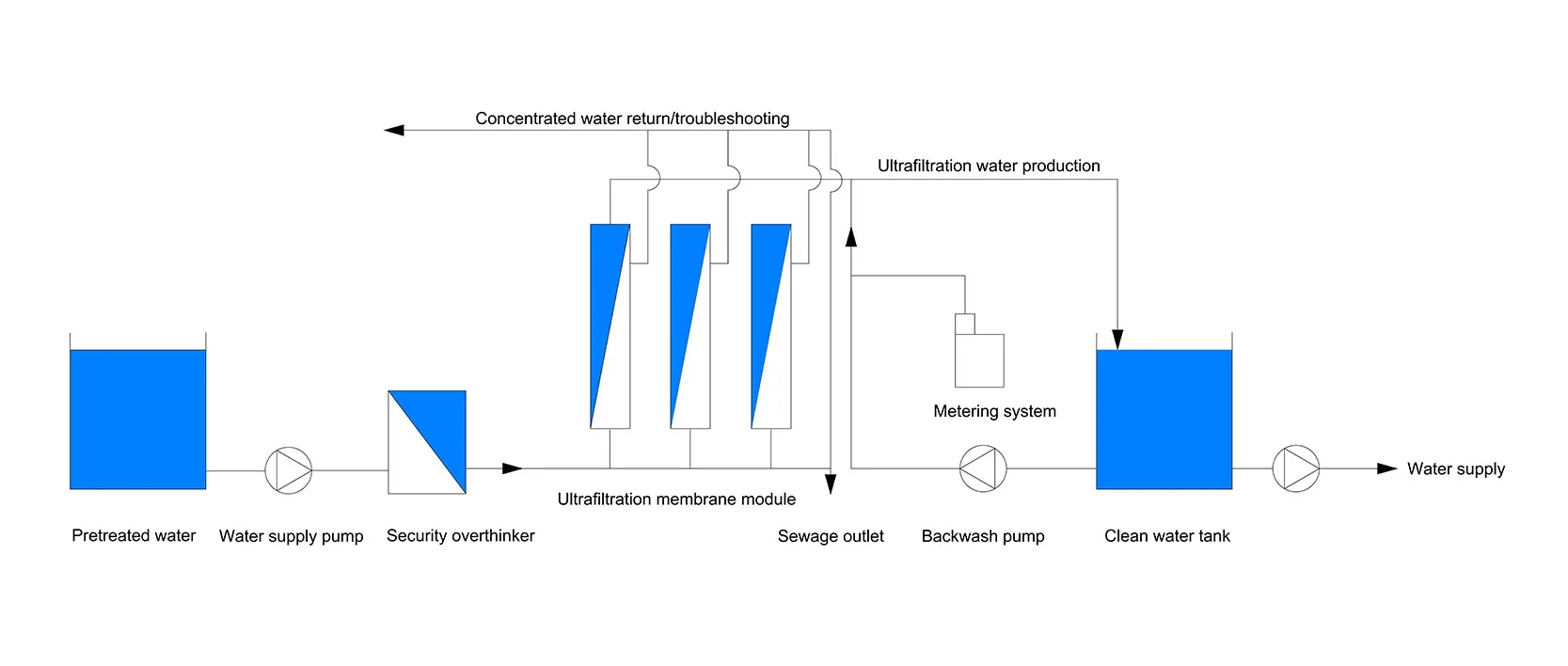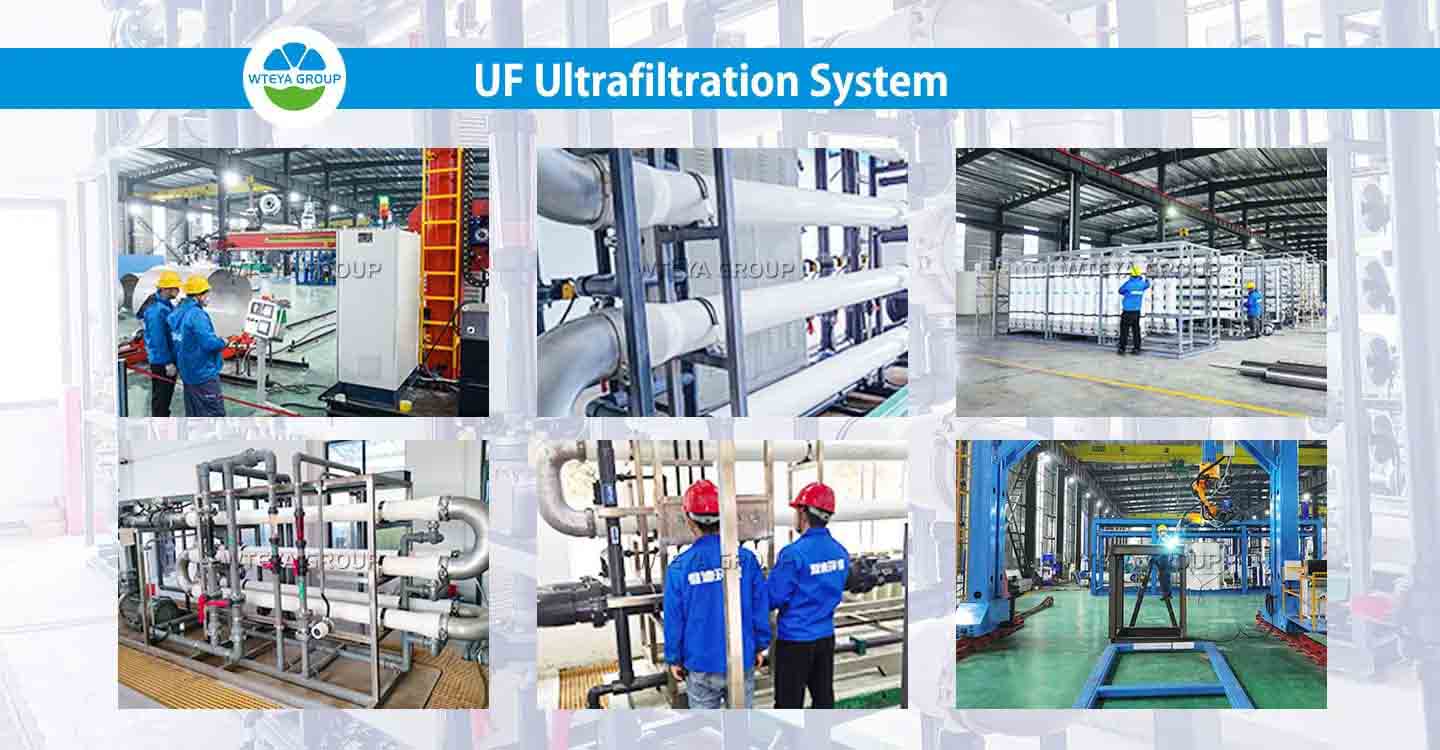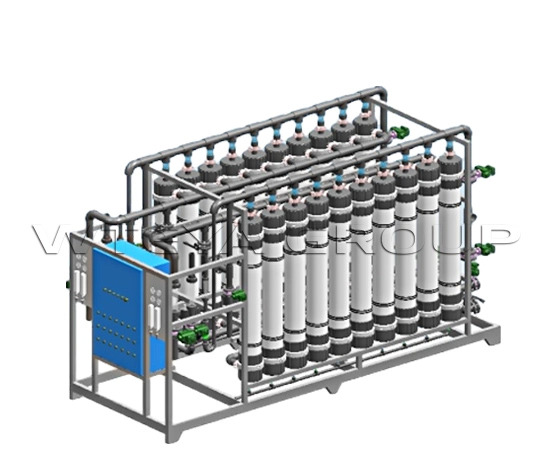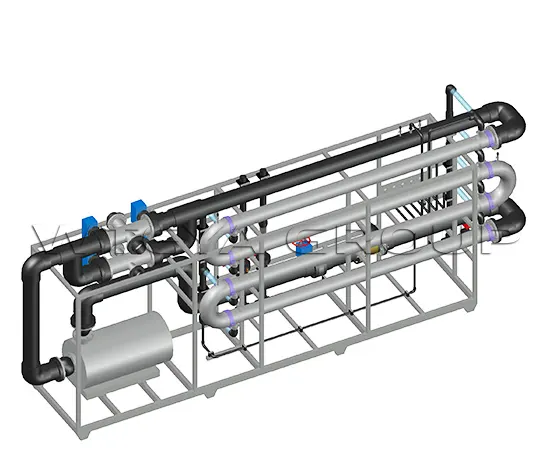Ultrafiltration Water Treatment Machinery
Menu
Latest News
Product introduction
Introduction to Ultrafiltration Water Treatment Machinery
Ultrafiltration water treatment machinery uses membrane separation technology to achieve efficient water purification. The equipment has the ability to remove impurities such as particles, colloids, bacteria, etc. in water and is suitable for a variety of occasions.
Ultrafiltration technology purifies water by using ultrafiltration membranes with a pore size of less than 0.01 microns (one hundred thousandth of a millimeter). This technology allows water molecules and some small molecular solutes to pass through, while intercepting suspended matter, certain colloids and microorganisms and other macromolecular substances to achieve the purpose of purification. Ultrafiltration water treatment machinery usually includes raw water system, ultrafiltration host, cleaning system and dosing system. These components work together to effectively purify water.
Ultrafiltration water treatment machinery composition
Ultrafiltration water treatment machinery has a complex structure, mainly including raw liquid, water intake pump, water storage device, feed pump, filtrate, bag filter, hollow fiber ultrafiltration membrane, on-site instrumentation, dosing system, fully automatic control system and rack platform. Customize pretreatment devices according to different raw water conditions, such as multi-media filters, security filters, etc., to ensure that the incoming water meets the requirements and prevent membrane pollution.
Features of ultrafiltration water treatment machinery
Efficient filtration capacity: Ultrafiltration water treatment machinery can efficiently remove particles, colloids, bacteria, heat sources and organic matter in water, and produce high-quality water.
Energy saving: General operation does not require a high-pressure pump, and energy consumption is low.
Easy maintenance: Few joints, low water pressure, low failure rate, and convenient maintenance.
High cost-effectiveness: simple operation, low cost, no need to add chemical reagents, and reduce operating costs.
Ultrafiltration water treatment machinery has significant advantages. Its membrane has high-precision filtration, good hydrophilicity, high strength, chemical resistance, antioxidant, easy cleaning and strong adaptability. It is widely used in water treatment, beverage processing, wastewater treatment and other fields.
Application field of ultrafiltration water treatment machinery
Drinking water treatment: Ultrafiltration technology removes suspended matter, organic matter, bacteria and viruses in water to improve the quality of drinking water.
Industrial water treatment: In large-scale industries, ultrafiltration technology treats water to remove impurities that affect product quality, accounting for 18%.
Recycled water, sewage and wastewater treatment and reuse: Ultrafiltration technology reduces environmental pollution in recycled water reuse and sewage treatment, and improves the recycling rate of water resources, accounting for 15%.
Food, beverage and pharmaceutical industries: Ultrafiltration technology is used for sterilization, turbidity removal, pyrogen removal and concentration processes to ensure product purity and safety.
Other light industries such as electronics, textiles, printing and dyeing, papermaking, etc. account for about 7%.
Seawater desalination: Ultrafiltration technology is used in seawater desalination to reduce salt and other impurities and obtain fresh water resources.
Technical principle of
Ultrafiltration operation principle (UF) is mainly based on membrane separation technology, it is a physical separation process using semi-automatic membrane with a certain aperture as filtration media. Under the action of the external pressure, when the liquid compound flows through the ultrafiltration membrane, the water molecules are smaller than the membrane aperture, solvent molecular and some small molecular material can go through the membrane hole smoothly, While molecular materials are bigger than the film aperture, colloidal particles, creatures, pests, etc. Blocked at the top of the membrane, thereby achieved the purity, separation, or concentration of solution. The specific process is as follow:
Rough fluid transportation: treated fluid (such as water, solution or mud) is inserted by the inlet of Ultrafiltration System under certain pressure.
Separation process: when the material liquids are in contact with the ultrafiltration membrane, only components smaller than the membrane aperture are allowed to pass through due to the limit of the membrane aperture. For example, if the film aperture is 0,01-0,1 micron, then the water, ion and other small molecular materials can pass through, while bacteria, virus, large molecular organic agents, colloidal particles, etc. V. T. Blocked at one side of the membrane.
Through and trap: small molecular material through the film hole will form a osmosis liquid, which is ultrafiltration through liquid, usually more pure; meanwhile, The electrolytes left by the film are stored at the highest side of the film, become concentrate or called ultrafiltration fluid.
Cleaning and reborn: with additional operating time, the ultrafiltration membrane surface can have sedimentation, absorbency, and even scale, resulting in the loss of membrane flow, Thus it is required to regularly clean chemicals or backflow to revert the separation performance of the membrane.
The production process of

Production of equipment

WTEYA aims to digital and intelligent production to provide superior products and services to its customers. We not only provide a wide range of standard products which are seriously tested and stable performance to meet a wide range of industrial needs. We also provide custom service, as well as OEM and ODM services, professional design team provides proper solutions for customers to meet their unique needs. We will work closely with each customer to ensure that every device suits customer's process requirements and production process accurately. WTEYA's one-stop service, innovative to create high-quality mechanical products and system solutions, professionally help customer deal with various water treatment problems.
Capacity and size
|
Ultrafiltration equipment parameter board |
||||
|
Cut out model |
Power rating of cloth |
Power of installation |
Main machine size |
The material is made of high quality |
|
WTY-UF-1 |
1000L/H |
1.0kw |
800 × 800 × 1500mm(H) |
304/ UPVC/ PVDF |
|
WTY-UF-2 |
2000L/H |
1.3kw |
1000 × 800 × 1500mm(H) |
|
|
WTY-UF-5 |
5000L/H |
3.7kw |
2000 × 1000 × 2200mm(H) |
|
|
WTY-UF-10 |
10000L/H |
6.4kw |
2000 × 1800 × 2200mm(H) |
|
|
WTY-UF-20 |
20000L/H |
18.5kw |
3600 × 2000 × 2600mm(H) |
|
Chart of effect chart


Frequently Asked Questions
Q: What particles of ultrafiltration film can remove?
Re: the ultrafiltration membrane can remove fine particles, suspended substances, some large molecular organic substances, bacteria and virus in water, but it will not be able to remove entirely small molecular substances like salt and sugar.
Q: How long life of ultrafiltration membrane?
Re: the lifetime of ultrafiltration membrane is affected by many factors, such as rough water quality, operating conditions, maintenance and maintenance, etc. V., usually can up to a few years. Frequent washing and maintenance can extend its life.
Q: How to deal with the pollution problem of ultrafiltration membrane?
Re: the pollution of ultrafiltration membrane can be processed by physical cleaning (such as pull or circulation washing) and chemical cleaning (specific chemical cleaners use).
Q: What kind of applications does the filtration system suit?
Re: the filtration system is suitable for many areas such as filtration water, waste water reuse, food and beverage, Biological Pharmaceutical, salt filtration pretreatment, etc. V. T.
Q: What parameters do you need to be noticed in the operation of the filtration system?
Re: the main parameters should be interested in Ultrafiltration System operation including the water pressure, water production, water quality status (such as turbidity and biological content) and the cross-film pressure difference, etc. V. T.
Q: Do filtration system need pre-treatment?
Re: in order to protect the ultrafiltration membrane and improve filtration efficiency, coarse water usually need to be pre-handled, including steps as suspension agent, adjust pH, soften.
Q: How about the energy consumption of Ultrafiltration System?
Re: the Ultrafiltration System has relatively low power consumption as it does not need high pressure pump to operate, but the specific energy consumption depends on the system design, scale and operating condition.
Q: Is Ultrafiltration System inexpensive for maintenance?
Re: compare to other film separation technology, the maintenance cost of Ultrafiltration System is lower, but still need to replace the film component regularly and maintain cleaning, the specific cost depends on the frequency of use and water quality condition.
Previous: Industrial Ultrafiltration UF System
Next: UF Ultra Filter System







